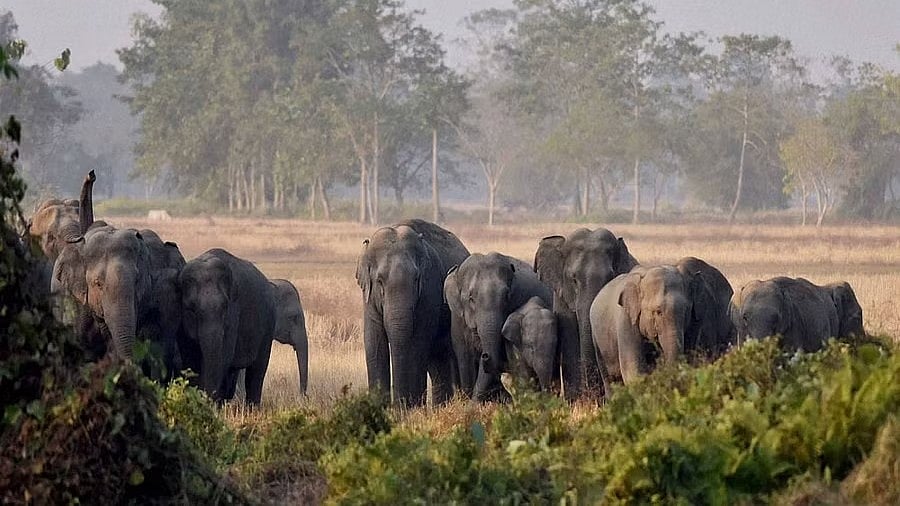
Image showing elephants. (For representation)
Credit: PTI File Photo
In seasons or certain periods that are prone to heat or prolonged droughts, providing water for wild animals may become important for maintaining ecological balance. Access to water ensures hydration, thermoregulation, and sustenance for various species, thereby mitigating the impacts of environmental stressors and promoting biodiversity conservation.
While people in urban areas of Karnataka worry about the lack of rains, there is also growing concern for the non-humans in the forested habitats. Often provisioning of water either through tankers or solar powered borewells inside the forests for elephants and other animals to quench their thirst during the dry season is considered an act of benevolence and a critical management tool to arrest deaths due to dehydration. Yet, studies conducted in the forests of southern India and in Africa have begun to show that such well-meaning interventions can have unforeseen and detrimental consequences to the elephants and its habitat.
Contrary to popular belief, water availability in human-provisioned water ponds or troughs within the forests of the Eastern Ghats of southern India (a dry zone) appears to have a weak but positive influence on the distribution of elephants during the dry season and has no effect on their distribution in the wet season.
Studies further reveal that the decision-making rules of elephants in the dry zone prioritise accessing areas with high forage availability and avoiding areas with high human activity during this season well over water sources. This may very well be due to the presence of perennial water sources such as the Cauvery and other rivers in the landscape that is used by wild animals during the drier months of the year. Wild animals such as elephants very often resort to digging small pits or wells using their feet, tusks and trunks to access water beneath the surface of dry sandy riverbeds too.
Furthermore, in the Western Ghats, research indicates that elephants exhibit a preference for natural water sources such as rivers and flowing streams during the dry season. Contrary to expectations, elephants are not necessarily drawn to human-made water troughs, highlighting the importance of preserving natural hydrological features in elephant habitats.
The artificial provisioning of water may disrupt natural behavioural patterns, fracturing the migratory behaviour of elephants who rely on rivers and streams as navigational cues. This disruption may have cascading effects on ecosystem dynamics, leading to habitat degradation and altered vegetation patterns. These findings call into question the necessity of artificial water provisioning for elephants, who naturally travel long distances and are migratory in nature.
Preserving natural sources
Evidence from the Kruger National Park in South Africa corroborates the detrimental effects of artificial water provisioning on elephant behaviour and ecosystem health. Artificial water points disrupted the traditional migration routes, confining elephants to localised areas and exacerbating habitat degradation.
The concentration of elephants around water troughs led to overgrazing and destruction of natural vegetation, further exacerbating ecological imbalances within the park, affecting multiple other species. In the Okavango delta of Botswana, stagnant water in water bodies became breeding grounds for toxic bacteria such as blue-green algae, posing a lethal threat to elephants. The mass die-off of close to 400 elephants in Botswana attributed to the cyanobacterial poisoning in 2020 by some studies serves as a stark reminder of such perils.
The priority of the forest managers would therefore lie in the preservation of natural water sources to safeguard elephant populations and ecosystem integrity. Ensuring free access to rivers and streams – preferred water sources for elephants during the dry season – is paramount. The artificial provisioning of water may also disrupt natural mortality rates, favouring the survival of weaker individuals at the expense of genetic diversity. Under unfavourable weather conditions, natural selection acts as a mechanism for ensuring the survival of the fittest individuals and perpetuating strong genetic lineages. Hence dying of elephants during such periods is natural and is a necessary mechanism through which populations are controlled naturally.
The scientific evidence available thus far indicates that artificial provisioning, although practised with the best of intentions, has adverse effects on elephant behaviour, ecosystem dynamics, and genetic fitness. We must therefore re-evaluate current management practices while prioritising the preservation of natural water sources to maintain ecological balance and promote the long-term viability of elephant populations. By refraining from interventions and allowing natural processes to unfold, we can uphold the integrity of ecosystems and ensure the survival of elephants in their natural habitats.
This is all the more true for urbanites, as most of us are dependent on the same river water that these wild animals need during these harsh periods. A judicious use of water and water conservation plans in the cities can therefore go a long way in helping the non-humans.
(The writer is a post-doctoral fellow, RS Lab, IISc, Bengaluru)